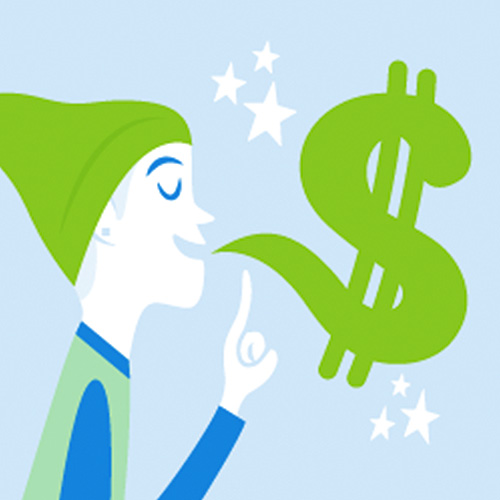
The money talk is an awkward one.
At least it is for us creatives.
Is it just me, or were most of us never trained to talk about payment as a legitimate, natural progression of any project we undertake? I recall learning how to account for my income at the year’s end, but what about how to acquire that sweet nectar in the first place?
In this series we’re going to cover how to start Billing Like a Boss. How to position yourself as an über-successful creative professional who deserves adequate compensation for your more than adequate work.
But in order to bill like a boss (and then get paid like a boss) you first need to learn how to talk about money (like a boss).
How should I bill for my work?
Would you believe there are heaps of ways to invoice clients? Heaps! For starters, you can charge by the hour, by the specific task, a flat fee based on project costs (plus a little something extra for yourself), or even a flat fee based on the value you believe your work will bring to your clients. Heck, you could bill based off of the enjoyment you get from doing the work (though I wouldn’t recommend it). Each method has pros and cons, but the key thing to remember that how you bill, in its own way, is a comment on your work.
For example, billing for time can give the impression that you’re just as skilled as the next person since it all comes down to hours, minutes and seconds in the end. Billing by task sends the message that not all work is created equal. That some tasks are harder, take more time, and therefore are deserving of higher compensation. Billing a flat fee takes into account the total value you bring to a project, value that can last long after your contract ends.
Take the time to consider how you want to be perceived as a creative professional (this includes the way you bill) and it will have long-lasting, lucrative effects on your career.
How much should I charge?
First, let me just say that I can’t tell you the exact figure to charge your clients. There are so many factors that go into pricing that if I were to spit out some form of Pricing Table, it would be irrelevant to the majority of people and I’d get sued into the stone age.
That said, there are several nuggets of wisdom to keep in mind...
First and foremost, you should think about your pricing long before you sit down with your client. Put on some good music and give yourself ample time to think about where you want to be one year from now. What sort of salary do you want to have? What sort of work do you want to be doing? It sounds a bit whimsical, but this is a legitimate target you will be aiming for over the next 12 months. This is what I like to call the best case scenario. It’s simply something to strive for.
Now for the not-so-best case scenario. Put on more good music and take stock of the recurring expenses in your life. Take into account things like:
- rent/mortgage payments
- general life expenses (ex. groceries, transit/gas, utility bills, etc.)
- a financial cushion for surprise expenses
- costs of running your business (ex. website hosting fees, equipment, professional services, etc.)
- other recurring costs
After jotting down the expenses you know are going to come your way in the next year, tally it all up and divide it by 50 (52 weeks in a year and everyone deserves a couple weeks off). This number is the minimum amount you should make as your average weekly income. Based off of this weekly income baseline, you can decide what price you can’t (ever) go under when accepting a project. Why? Because it will actually cost you money to accept the project, and you may even end up turning down a higher-paying job because you’re busy with this other one you’ve committed to.
So now you know what salary to aim for and what is at least acceptable. But how does a savvy creative ever raise their prices to achieve best case scenario-ness? I recommend getting into the habit of tracking your time so you know exactly how long different tasks take you. If you’re billing hourly and you discover that you’re becoming quite fast at a task without losing any of the quality—raise those rates! Intentional or not, you’re spending less time performing the task, but that doesn’t mean you deserve to be paid less for achieving the same outcome.
Last but absolutely not least, discuss your pricing with your client before you begin any work. Counterintuitive as it may feel, your clients would prefer to know your pricing up front because (just like you) they have other expenses that they need to accommodate for. Keep in mind that people equate value with price, so don’t undersell yourself. Just like brand name clothing, people buy expensive things to feel better about themselves. So give your clients the luxury of knowing they’re working with the best by virtue of the fact that you didn’t low-ball yourself when discussing payment.
When should I send my invoice?
Depends.
Short projects offer a bit more flexibility because the scope is much smaller and there is less time for forgetfulness to set in. Try to invoice your clients as soon humanly possible when you’re done your work for a short-term project. It might feel like you’re rushing the gimme money part, but you’re actually signaling to your clients that you’re so on the ball that you don’t drop a beat—even at the very end of a project (which is easy to do). Clients will be grateful that you’ve taken the initiative to pivot your focus to billing, thus taking one less thing off their plate.
Long projects require a bit more thought when it comes to your invoicing structure. Depending on the scope and longevity of the project, you’ll want to take into account if you need to cover any project-related costs, pay rent, eat.
I recommend billing long-term projects in installations for two giant reasons.
First, to make sure you have enough to live on and cover the aforementioned costs while you’re doing the work.
Second, so that you don’t shock your clients with a whopping-big invoice at the very end, or worse, shock yourself and shave the total down to a number that’s a little easier to swallow. You put in the work. It wasn’t for your health, and trust me when I say your past self who spent three hours touching up photos will want to get paid for every millisecond.
When should I follow up on a late payment?
Short, cryptic answer: when you said you would.
Longer, more descriptive answer: take time to decide (and then communicate to clients) when is a logical amount of time to follow up and then stick to it.
If you find that your clients usually take about a week to get their finances in order after you’ve sent your invoice (and you’re ok with that), send your reminder eight or nine days after project completion. If you find that your clients take a solid month to remember to pay (and you’re not ok with that), send your first reminder about one week after the project is completed. This way you’ll still have a couple of weeks to gently remind clients to pay and get the ball rolling before your own finances get too tight.
The best thing you can do to ensure prompt payment is to specify up front when payment is expected and what will happen in the instance of late payment. It doesn’t have to be a harsh conversation. Simply let your clients know what will happen so that they know to expect either a friendly “just checking in” email or late fees on their invoice. This is by no means a slap on the wrist. Just like your friendly, local library, if you bring your books back late, there’s a fee—and that’s just business.
To sum up—you deserve to be paid for your work
If you enjoyed doing the work so much, you wouldn’t bother invoicing your clients in the first place, right? So, if you’re going to ask for any money at all—ask for the full, fair amount. Remember that how you bill (hourly, flat, value-based) sends its own message, so take 20 minutes to pick a billing structure that keeps your cash-flow flowing, and presents you as the creative professional you are. Know what income level you can’t go under and stick to your guns, then raise your pricing as you become faster at completing your work. Be insanely prompt when requesting payment for short-term projects and opt for payment installations for longer ones. Let your clients know ahead of time when you will be following up on late payment, that way it’s no surprise and you won’t have to wing it every time.
It feels like doing all this will make you come off as money hungry or a Type A personality on steroids. However, starting a dialogue about your compensation on a positive, objective note will make the (inevitable) Money Talk less awkward and present you as total professional.
One thing I find crazy helpful for making things less awkward is to have some sort of a middle man. Some sort of automated system that does the “payment asking” for you. That’s not to say you don’t need to be confident when discussing compensation for your work. But having something that facilitates the conversation will help to move things along at a comfortable pace.
Next we’ll dive a little deeper into billing like a (big, bad) boss. More specifically we’ll look at The Anatomy of an Invoice (That Gets Paid), and what it says about you to your clients—whether you like it or not.
Read More at Money Talks | How to Start Billing Like a Boss
from Web Design Ledger http://webdesignledger.com/money-talks-how-to-start-billing-like-a-boss
No comments:
Post a Comment